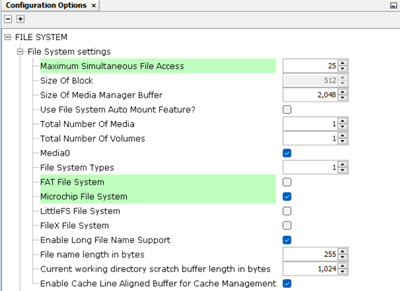1.7 TCP/IP SNMP NVM MPFS
The Microchip SNMP Server is a multi-lingual implementation, which supports SNMPv1, V2c, and V3 server features simultaneously. The SNMP Server is implemented to address the requirements of embedded applications and works with both IPv4 and IPv6 addresses.
Description
The TCP/IP SNMP NVM MPFS application is based on MPLAB® Harmony 3 TCP/IP Stack.
The Harmony TCP/IP stack is a collection of different network protocols.
The source files of Harmony 3 TCP/IP stack is available here.
The demo is created with MPLAB X IDE and MCC plugin.
MCC Project Graph - TCP/IP SNMP NVM MPFS
The following Project Graph shows the Harmony components included in the TCP/IP SNMP NVM MPFS demo application.
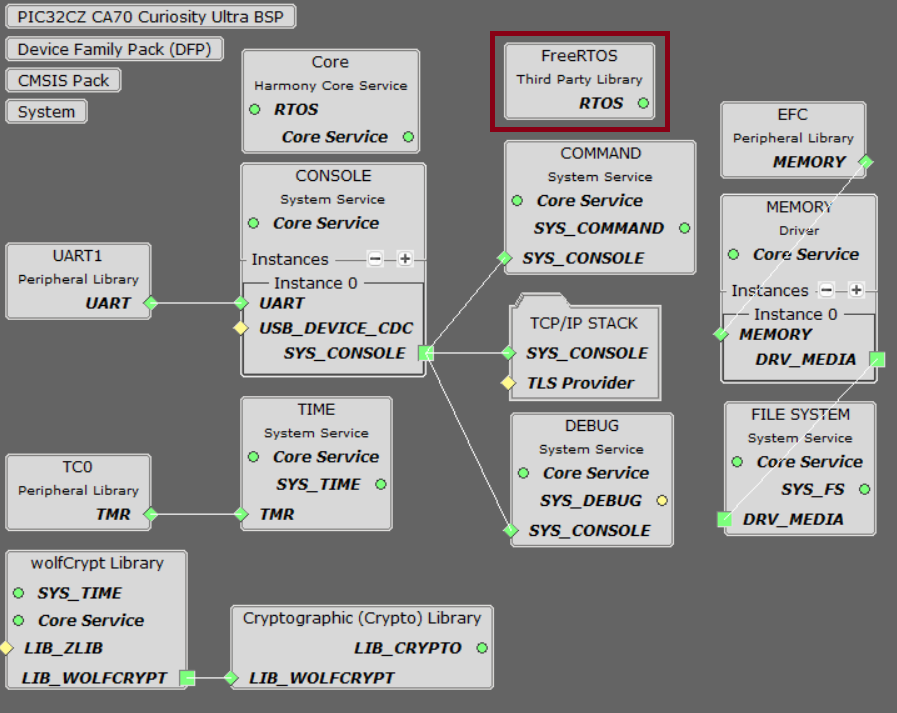
wolfSSL component is added for secure connection which supports TLS.
wolfCrypt module enabled with MD5 and SHA authentication
FILE SYSTEM is added to select Memory module with Microchip file system (MPFS).
FreeRTOS component is required for RTOS application. For bare-metal (non-RTOS) FreeRTOS component should not be selected.
TCP/IP Configuration - TCP/IP SNMP NVM MPFS
The TCP/IP modules enabled for the demo is shown in the TCP/IP Configuration Overview
More details of TCP/IP Configuration plugin is available here
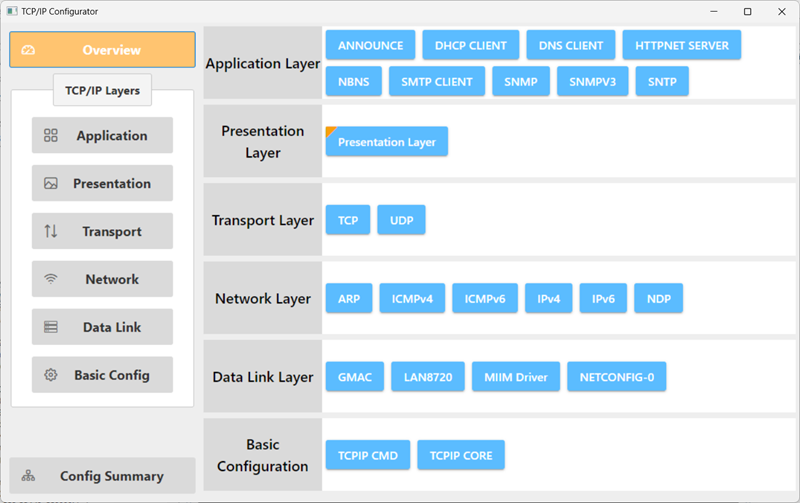
The Application Layer modules enabled in the demo are as follows:
- Application Layer Modules
- ANNOUNCE to discover the Microchip devices within a local network.
- DHCP Client to discover the IPv4 address from the nearest DHCP Server.
- DNS Client provides DNS resolution capabilities to the stack.
- HTTPNET SERVER enables the target board to act as a Web Server for the secured port number 80.
- NBNS NetBIOS Name Service protocol associates host names with IP addresses. This assign of human-name host names to access boards on the same subnet.
- SMTP CLIENT let applications send e-mails to any recipient worldwide.
-
SNMP and SNMPv3 are an application layer protocols that facilitates the exchange of management information among network devices.
Maximum SNMP Message Size can be increased and the value should be multiple of 32 bytes for larger GET-Bulk response.
- SNTP Simple Network Time Protocol updates its internal time periodically using a pool of public global time servers.
Downloading and Building the application
To clone or download this application from Github, go to the main page of this repository and then click Clone button to clone this repository or download as zip file.
This content can also be downloaded using content manager by following these instructions.
Path of the application within the repository is apps\snmpv3_nvm_mpfs\firmware
To build the application, refer to the following list of demo configurations and open the project using MPLAB X IDE.
| Project Name | Target Device | Development Board | Description |
|---|---|---|---|
| pic32cz_ca70_curiosity_ultra.X | PIC32CZ2051CA70144 | PIC32CZ CA70 Curiosity Ultra + LAN8720 PHY Daughter Board | TCP/IP SNMP NVM MPFS Application - Bare Metal |
| pic32cz_ca70_curiosity_ultra_freertos.X | PIC32CZ2051CA70144 | PIC32CZ CA70 Curiosity Ultra + LAN8720 PHY Daughter Board | TCP/IP SNMP NVM MPFS Application - FreeRTOS |
Hardware Setup - PIC32CZ CA70 Curiosity Ultra
The target board for running the application is PIC32CZ CA70 Curiosity Ultra.
This section provides essential hardware configuration of this target board to run TCP/IP applications.
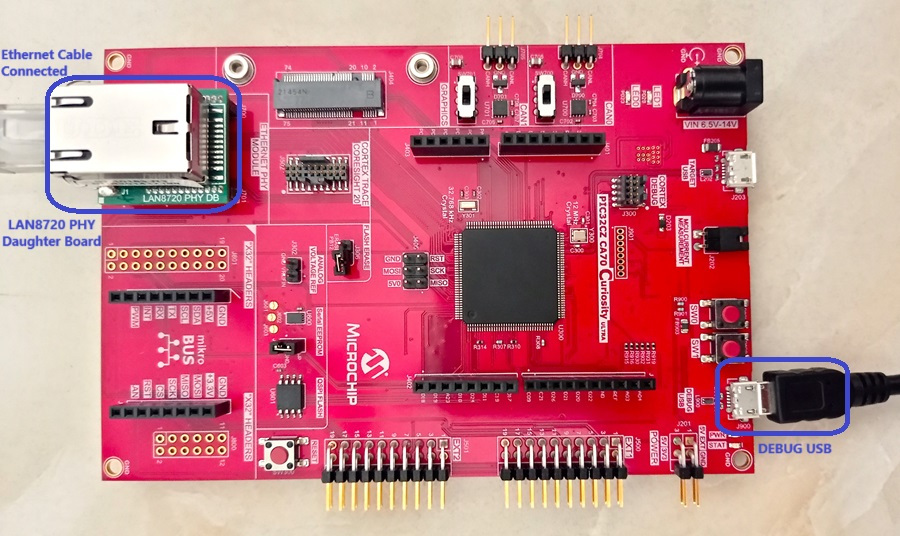
Board Setup
To set up the hardware, refer to the PIC32CZ CA70 Curiosity Ultra User's Guide.
- Default jumper setting of the board is shown above.
- Connect the micro USB cable between DEBUG USB port on the board and host PC.
- Establish a connection between the router/switch with the PIC32CZ CA70 Curiosity Ultra board through the RJ45 connector, using the Ethernet cable.
Running the Application
The HTTPNET Server module uses Microchip Proprietary File System (MPFS) to read web pages from the Non-Volatile Memory (NVM). The Non-Volatile Memory (NVM) is one of the memory media is used to store the web server pages.
- Open a terminal application on the host computer (like Hyper-terminal or Tera Term).
- Configure the terminal application for serial virtual COM port.
- Set baud rate as 115200 in the terminal application.
- Build and download the application project on the target board.
- Verify the TCP/IP Stack initialization console messages.

If DHCP client is enabled in the demonstration, wait for the DHCP server to assign an IP address for the development board.
This will be printed on the console. Otherwise, the default static IP address will be assigned to the board.
By entering the command netinfo, the response is obtained as shown above.
Web Server Test
- Open a web browser (like Google Chrome, etc).
- Type the board URL in the address bar of web browser (for example, https://mchpboard_c or https://<ip-address as shown in the console> ).
- The web browser display following web page
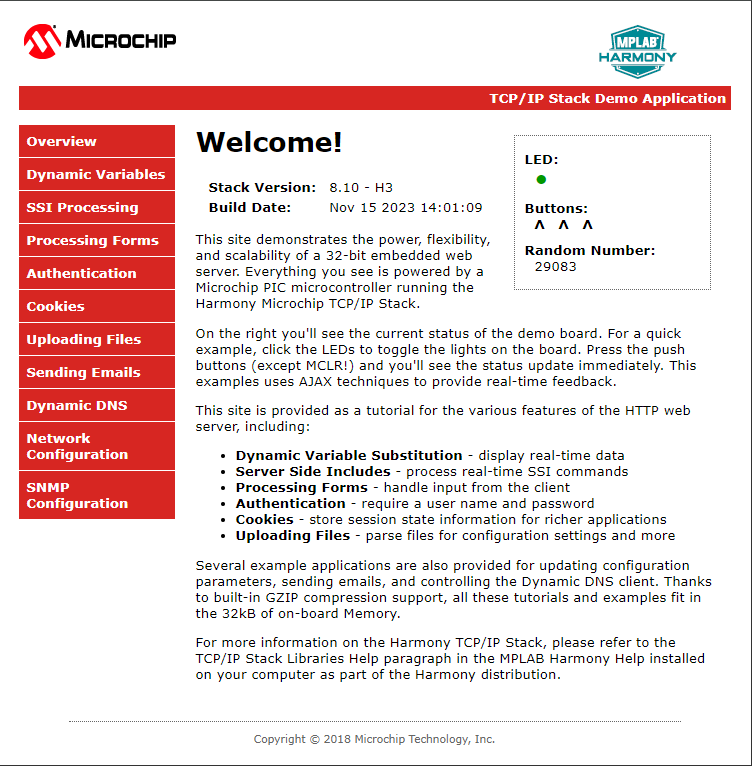
Application features are:
- Dynamic Variables and Real-time Hardware Control - Pressing Switches on target board toggles buttons on web page. Similarly, Clicking on LED symbol in web page can toggle LEDs on target board.
- Form Processing - Input can be handled from the client by the GET and POST methods.
- Authentication - Shows an example of the commonly used restricted access feature.
- Cookies - Shows an example of storing small text strings on the client side.
- Server Side Includes - An example of how SSI can be used to support dynamic content.
- File Uploads - Shows an example of a file upload using the POST method. The HTTP server can accepta user-defined MPFS/MPFS2 image file for web pages.
- Send E-mail - Shows simple SMTP POST methods
- Dynamic DNS - Exercises Dynamic DNS capabilities
- Network Configuration - The MAC address, host name, and IP address of the evaluation kit can be viewed in the Network Configuration page and some configurations can be updated
- MPFS Upload - A new set of web pages can be uploaded to the web server using this feature, which is accessed through https://mchpboard_c/mpfsupload (or) https://<ip-address as shown in the console>/mpfsupload
Notes:
- For the LED and SWITCH demo functionality, configure the GPIOs connected to LEDs and Switches on target development board, through the Pin Configuration in MCC.
- The location of the MPFS image is fixed at the beginning of the Flash page specified by DRV_MEMORY_DEVICE_START_ADDRESS. The size of the MPFS upload is limited to DRV_MEMORY_DEVICE_MEDIA_SIZE in the demonstration. The HTTP File Upload functionality has to be enabled when the project is generated.
SNMP Test
-
The SNMP and SNMPv3 server is hosted by the application.
-
Open a SNMP manager (iREASONING SNMP manager is recommended) and Follow the steps given in iREASONING Networks MIB Browser section in the Third-Party help for complete details on using and configuring the application demonstration using the iREASONING SNMP Manager.
-
SNMP MIB Browser -
-
Several SNMP MIB browsers are available. Users can also install a customized MIB browser specific to their application.
-
Verify SNMP Get, GetNext, GetBulk, Set requests and Get response operations .
-
For SNMP v2c , the Agent can be configured with three Read communities (E.g - "public", "read", " ") and three Write communities (e.g - "private","write","public").
Community Index Read Write 1 harmony unicorn 2 read write 3 harmony Figure 1-22. Also the SNMP v2c Community string can be Configured from the web browser.
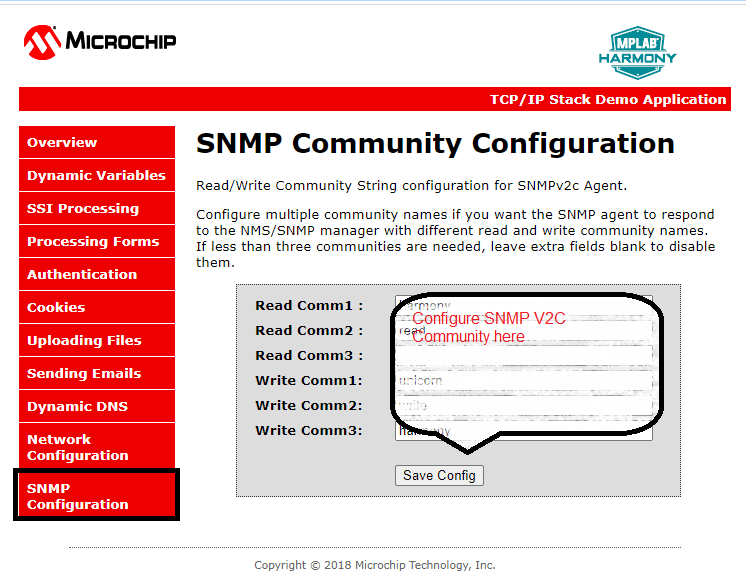
-
-
For SNMP v3, the Agent is configured as per the following table:
Type USER 1 USER 2 USER 3 USM User microchip SnmpAdmin root Security Level auth, priv auth, no priv no auth, no priv Auth Algorithm MD5 SHA1 N/A Auth Password < As Per The Configuration > < As Per The Configuration > N/A Privacy Algorithm AES N/A N/A Privacy Password < As Per The Configuration > N/A N/A The Microchip SNMP Stack supports both TRAP version 1 and TRAP version 2. The default trap output is a multi-varbind SNMPv3 TRAP version 2. Trap receiver setting of iReasoning to be selected and configured to visualize the trap output in the iReasoning MIB browser.

